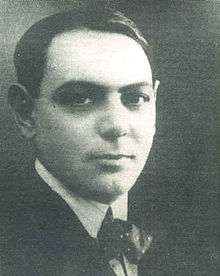Vicente Greco

Vicente Greco (February 3, 1888 – October 5, 1924) was an Argentinian composer, conductor, and bandoneon player of tango music. He had a significant role in the spread of tango music from the suburbs into the cities, where it became very popular.[1]
Life story
Born in Buenos Aires, he was a son of Genaro Greco and Victoria Santo, a couple of modest means who brought up Vicente and seven other children.[2] The small family income caused Vicente to work at a young age; his schooling was interrupted, and he instead became a newspaper hawker, shouting out headlines to sell newspapers in the streets. Several of his siblings were also musically inclined. Vicente's musical career began around 1903 during his teens, when he played guitar complemented by singing, for fun.[2]
Greco learned to play a concertina that had been given as a gift to his parents, and then his parents gave the 14-year-old prodigy a bandoneon as a gift for the 14-year-old prodigy. The first tango he played was "La Tirana", and he initially worked in bars and lounges that were popular in the neighborhood of La Boca, one of the main neighborhoods of immigrants in Buenos Aires. He debuted in San Pedro, San Nicolás, Baradero, Rosario, and elsewhere.[2]
In San Pedro, he got to know and play music with leading performers of that era, including Prudencio Aragón (El Johnny), Ernesto Zambonini (El Rengo), Lorenzo (El Negro) and Juan Borguessi (El Taruguito). But in San Pedro he also had a serious accident due to a stage collapse, and this may have contributed to his early death.[2]
Greco obtained a harmonium that he used for practice and for composing. He had dark eyes, and was short, with a tendency toward frequent good humor. He led the first group known as an orquesta típica, which means an orchestra specializing in tango, and that group was called Orquesta Típica Criolla.[3]
 |
Don Juan (3:29)
Piece by Ernesto Ponzio played by the , Orquesta Típica Criolla led by Vicente Greco, Buenos Aires, 1910 |
| Problems playing these files? See media help. | |
As a self-taught musician, he initially needed the help of fellow musicians to commit his music to paper. Among the venues where Greco played was the Rodríguez Peña Saloon, in which, one evening in 1911, the tango "Rodríguez Peña" was premiered with a very warm reception by the audience, who followed their applause by carrying him on their shoulders victoriously along the street outside. Also in 1911, he was the first tango musician to be hired at the Armenonville, a musical cabaret that became one of the main centers of diffusion of the tango.[2]
His tangos sold well; 22,000 copies of his first tango "El morochito" (written in 1905) were sold, "Rodríguez Peña" sold 12,000 copies, and "El flete" sold 6,000 copies in three months. Numbers such as "Rodríguez Peña", "La viruta" or "El flete", were classics of the genre. The famous singer Carlos Gardel was his personal friend and a musical collaborator.[2]
Greco's recording work began around 1910. He was accompanied by the same instrumentalists with whom he had already appeared at the Café El Estribo: Lorenzo Labissier (bandoneon), Domingo Greco (piano), Vicente Pecci (El Tano) (flute) and Palito Abatte or, on occasions, Francisco Canaro (violin).[2]
Tangos by Greco
|
|
|
References
- ↑ Frank, Patrick. Los Artistas Del Pueblo: Prints and Workers' Culture in Buenos Aires, 1917-1935, pp. 163-164 (UNM Press, 2006).
- 1 2 3 4 5 6 7 Silbido, Juan. "Vicente Greco", todotango.com. Accessed November 3, 2015. This material is excerpted from the following book by the same author: Evocación del Tango (Buenos Aires, 1964).
- ↑ Finkielman, Jorge. The Film Industry in Argentina: An Illustrated Cultural History, pp. 27-28 (McFarland, 2003).